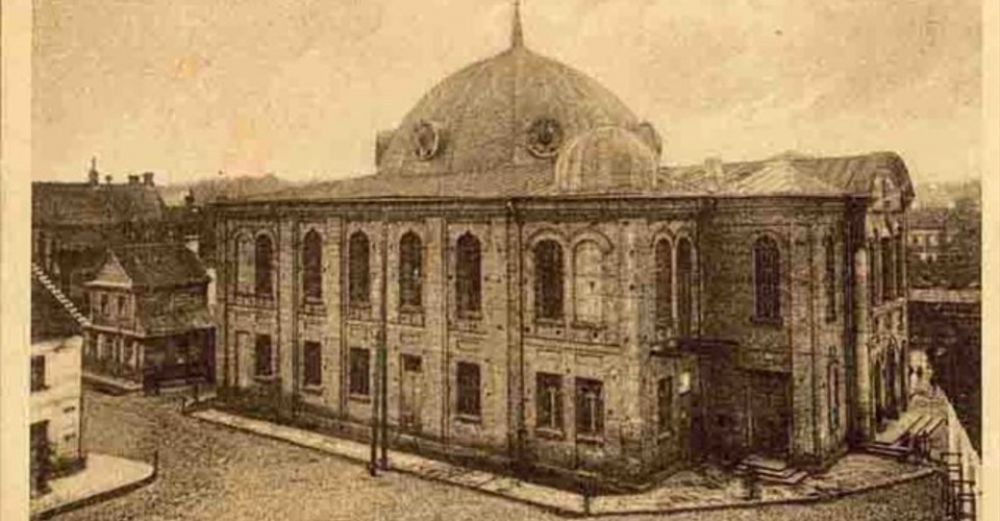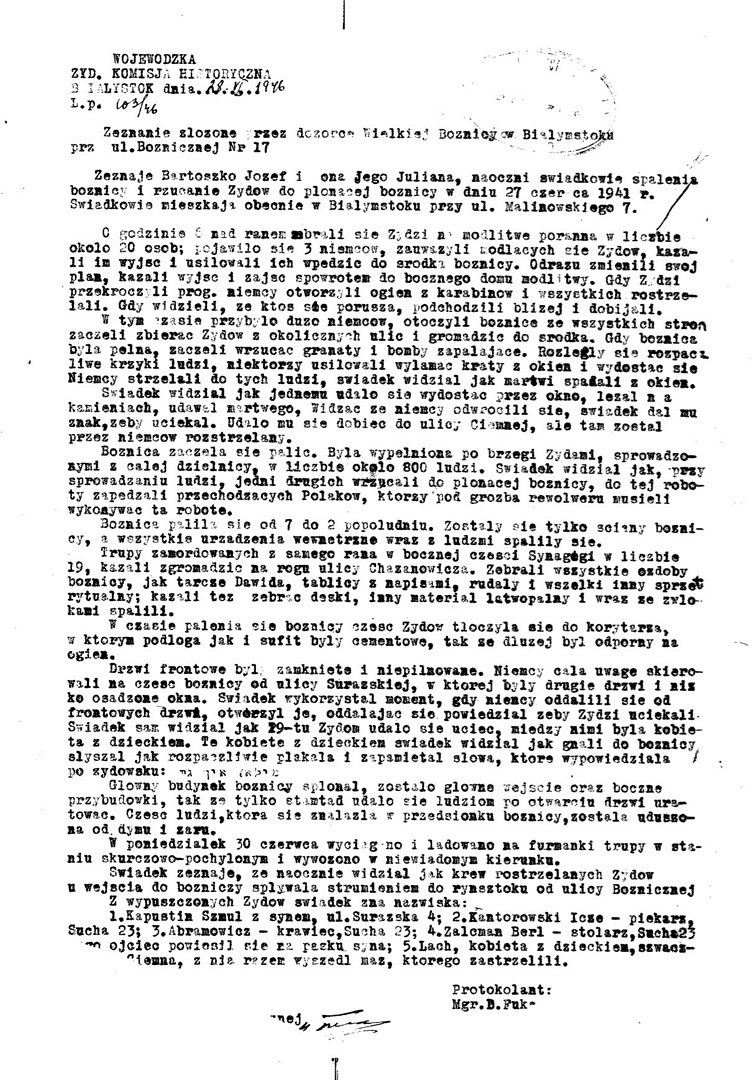- News
- Events
- Oneg Shabbat
- Collections
- Research
- Exhibitions
- Education
- Publishing Department
- Genealogy
- About the Institute
- Bookstore


The pogrom of the Jews began on June 27, 1941, on the day the Germans entered Bialystok. People were pulled from their homes, shot on the streets, and about 600–700 people were round up to the Great Synagogue, which was then set on fire. Over a dozen of people escaped from the building thanks to help of Polish caretaker — Józef Bartoszko, who opened a side window. In total, about 2,000 Białystok Jews died that day.

In the book Walka i zagłada białostockiego getta [The Fight and Extermination of the Białystok Ghetto] which was published for the first time in 1946, Szymon Datner reports on the events that took place on this day:
Incidents which followed one after another in Białystok after the outbreak of II WW were to local Jews as a hit of the club in the head. Germans enter on the 27th of June (Friday) and ’make their debut’ by burning 800–1000 Jews, men and boys, alive in the Great Synagogue, burning Szulhojf (neighborhood surrounding the Great Synagogue) and killing another thousand in mass executions on the streets.
On this ill-fated Friday morning quite big motorized unit concentrated on Sienna Rynek (at Mazowiecka Street) and Germans having rolled up their sleeves began soaking alcohol and be deployed in Szulhojf few minutes later.
The bloodbath began at 8 o’clock in the morning. Germans, divided into small units, armed with submachine guns and hand grenades, started hunting for Jews in narrow and winding streets around the Great Synagogue. Dantesque was happening on the street, Jews were brought outside, lined up against the wall and shot. Groups of poor sods were brought from all directions and pushed towards the Great Synagogue which was burning with great flames, with ear-piercing screams coming out of it. Germans forced their victims, to push each other, one by one, into to the burning temple. Those who resisted were shot and their bodies were thrown inside. Soon, all the neighborhood surrounding the Synagogue was burning. Soldiers were throwing hand grenades into houses, most of which were wooden and caught fire easily. The sea of flames which engulfed the entire Szulhojf, flooded Legionowa and Suraska Streets as well as Rynek Kościuszki. Jews were dragged towards the burning Synagogue until late afternoon, were shot in the streets and in the houses. Bangs of exploding grenades mixed with gunfire noises, roars of drunk German mob and despairing cries of murdered victims. Germans were ’gallant’ towards women, i.e. as a general rule they didn’t kill them, but only by beating them and yelling at them they forced them to quickly leave burning neighborhood, prior to which they were killing their husbands, brothers, sons and fathers right in front of their eyes. In one case they stretched their courtesy very far: Ida Lewitańska (née Krywiatycka), 8 months pregnant, who escaped the Szulhojf hell together with few women and men, encountered Germans who in their presence, against the wall of Midówka building on 9 Legionowa Street, executed 200 Jews. Elder German, who noticed the state she was in, let them go. The Synagogue was burning for few days. A worth mentioning event happened to Jews of Białystok on this ’Black Friday’. The temple keeper, a Pole whose name remains unknown, took advantage of the moment of Germans’ distraction and opened a window in wall at the rear of the Synagogue, through which several Jews managed to escape. Among the rescued were Pejsach Frajnd, Lewitańska’s brother-in-law; Frajnd was killed few days later as one of the ’Thursday victims’ [di donersztike — as those who perished on 3rd of July 1941, ca. 300 people, were referred to]. In the flames of the Great Synagogue perished, among many others, well known in Białystok doctor Kacowski, pharmacist Polak (limp), known chess player Zabłudowski and popular badchen Alter Sztajnberg.
The gleanings of the ’Black Friday’: approx. two thousand killed, burnt Szulhojf neighborhood together with the streets: Chazanowicza, Szkolna, Ciemna, Głucha, Stolarska, Zamojska, Suraska, Sucha, Miodowa, Śledziowa, Brzozowa, Bóżnicza, Wersalska, Ordynacka; seriously damaged were the streets: Legionowa, Rybny Rynek and Rynek Kościuszki...
A monument in the shape of a destroyed synagogue’s dome, unveiled in the place where the synagogue stood years ago, reminds about the events of June 27, 1941. Its founders were Białystok Jews from all over the world.